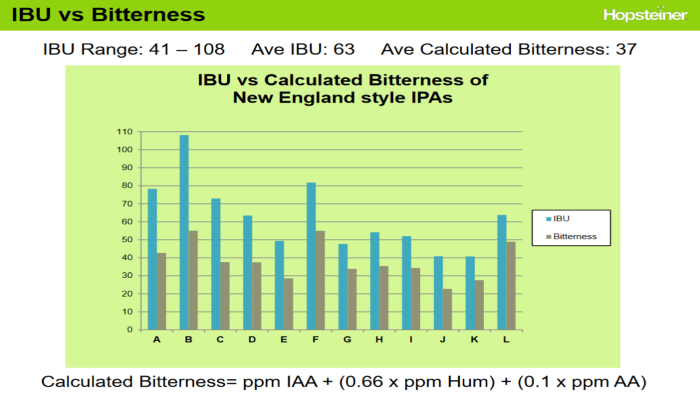From Vol. 2, No. 7, November 2018
John Paul Maye’s presentation titled “Hidden Secrets of the New England IPA” was chosen best presentation at the MBAA/ASBC Beer Summit by both those attending and the program committee. Maye is technical director at Hopsteiner and I’ve mentioned his research revealing the hidden secrets of humulinones more than once here. Hopsteiner analyzed 12 commercial NEIPA using High Performance Liquid Chromatrography (HPLC) and freeze dried the haze to determine its constituents (how cool is that?). The conclusions, with some additional details in italics:
– The smooth bitterness that many people experience drinking NEIPAs is due to the high humulinone concentrations in these beers and low concentration of isoalpha acids. Again, you’ll find more about humulinones in the archive. In heavily dry hopped beers the concentration of isoalpha acids decreases as more hops are added and the concentration of humulinones increases.

– The sensory bitterness of NEIPA is about half of what the IBU test result would indicate. This is due to the fact that alpha acids and humulinones interfere and absorb like isoalpha acids during the IBU test yet are only 1/10 and 2/3 as bitter as isoalpha acids. Decoded: a laboratory test measures a lot of “stuff” beyond iso. Hopsteiner did that test for each beer, but also calculated sensory bitterness as a sum of actual iso, two-thirds humulinones and one-tenth alpha acids. As a result, Beer B had a measured IBU or more than 70, and sensory bitterness less than 40. That was a pretty typical difference.
– The foam quality of NEIPA is very good and this is due to the high protein and high alpha acid concentrations in these beers.
– The haze stability of NEIPA is not very good, with most beers dropping to less than 100 NTU within one to two months after packaging. NTU is a measure of turbidity. One measured more than 900, two others more than 600, another 300-plus, and the others between 80 and 200. 1 million cells/mL contributes only 8.5 NTU. One beer had 5 million cells/mL (and 95 NTU), but most less than 1 million/mL.
– Analysis of the haze shows ~36% protein, ~ 3% polyphenols, 0.9% fatty acids and 11% hop acids. The use of high protein adjuncts rich in prolamines like oats and wheat (haze proteins) are known to combine with polyphenols to form haze. Due to the very low yeast count in most of these beers, yeast is generally not a contributor to haze. Polyphenols are present in both malt and hops.
– The haze in New England style IPAs can act as a carrier and increase the concentration of non-polar hop compounds like myrcene, alpha acids, xanthohumol and beta acids which are found in lower concentrations in West Coast style IPAs.
In an email, Maye wrote that further research will look into what other non-polar hop oils are caught up in haze. These likely will include oxygenated compounds, but not thiols. “Thiols are fairly polar compounds so I wouldn’t expect an enrichment of those due to the haze,” he wrote. “One of the things I found interesting is that we didn’t see a lot of soluble hop compounds like isoalpha acids or humulinones in the haze precipitate. That makes me believe the haze is acting more like an emulsifier than a trap.”
You may listen to him discuss this on an MBAA podcast.